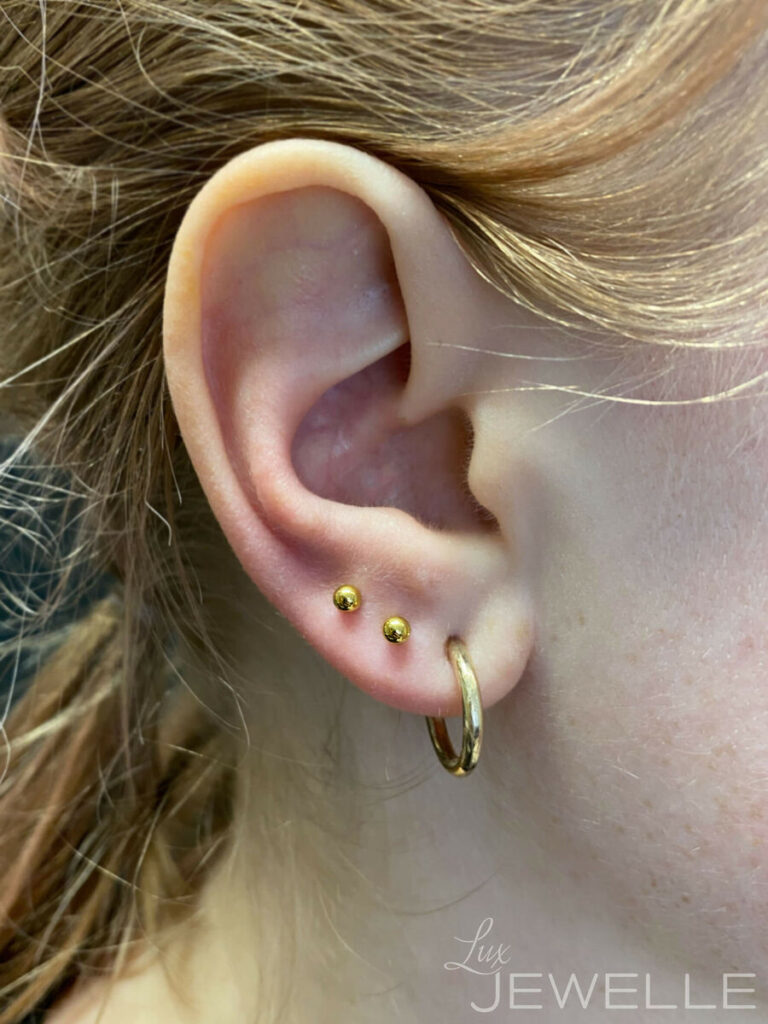A professional piercer’s perspective on materials and body safety
Gold-plated jewelry has become increasingly popular – it offers the luxurious look of gold at a more affordable price. But are these pieces really safe to wear in piercings? How can you tell if a gold-plated piece is actually suitable for your skin? In this article, I’ll break down everything you should know about gold-plated piercing jewelry – from a piercer’s point of view – so you can make safe, informed choices.
Why is gold-plated jewelry so appealing?
Gold has always symbolized elegance and timeless beauty. Solid gold jewelry – like 14K or 18K – is often seen as the highest quality, but it can also be out of reach for many, especially if you’re wearing multiple pieces. That’s where gold-plated options come in: they offer the look and glow of real gold at a much lower price.
But price shouldn’t come at the cost of safety, especially with something that goes into your body. That’s why it’s crucial to understand what gold plating really means, the methods used, and – most importantly – what’s underneath that shiny surface.
What does “gold-plated” actually mean?
“Gold-plated” can mean many things, and the quality can vary dramatically depending on:
- how the gold was applied
- what type of gold was used
- and what the base material is under the coating
PVD Coating – the body-safe gold plating method
PVD (Physical Vapor Deposition) is a high-tech vacuum coating process in which pure 24K gold is vaporized and bonded to the jewelry’s surface in an ultra-thin but durable layer. This method is:
- chemical-free (no solvents, no glues)
- smooth and precise (no patchy or uneven finishes)
- eco-friendly (no toxic byproducts)
Unlike traditional gold plating, PVD does not flake or peel over time – it wears down slowly and evenly.
More durable than anodizing
You might have come across anodized titanium jewelry, where the surface color is changed using electric current without adding an external coating. While anodizing is safe, it wears off much faster than PVD, and the resulting color is not gold-like – it’s more yellow or orangey.
PVD coating, on the other hand, offers a richer, more gold-like appearance and lasts significantly longer, making it a better option when you want that golden look to stay beautiful for longer.
The core material matters – what’s underneath the gold?
What lies beneath the plating is just as important as the plating itself. Many cheap gold-plated items are made from brass, copper, or other mixed alloys, which can:
- irritate the skin
- release nickel
- trigger allergic reactions
Certified implant-grade titanium – proven safe
All gold-plated jewelry sold on LuxJewelle’s website is made by Invictus Body Jewelry – a globally respected manufacturer known for exceptional quality and ethical production.
Invictus’ gold-plated pieces are crafted from certified implant-grade titanium (ASTM F136 Ti-6Al-4V ELI) – the same material used in surgical implants. That means:
- Completely nickel-free
- Hypoallergenic
- Independently lab-certified via XRF and ICP analysis
According to Invictus’ official certificate of analysis, the tested composition was: 89.42% titanium, 5.81% aluminum, 4.46% vanadium, and just 0.3% iron – all within ASTM F136 standards. The result was marked PASS, confirming the material is pure, traceable, and safe for use in the body – even once the surface coating wears down.
How does the coating perform over time?
While PVD is more durable than traditional plating, it’s not permanent. With regular wear, the coating may:
- slowly fade – especially if worn inside the mouth or with constant rubbing (e.g. from glasses)
- maintain its shine for a long time when used gently and kept clean
Crucially, once the coating does wear, the jewelry underneath remains completely safe. Unlike low-quality jewelry that hides harmful materials under gold, implant-grade titanium is safe for skin contact even without plating.
Summary: When is gold-plated jewelry a good choice?
Gold-plated titanium jewelry is a great option when you:
- want the look of real gold at a lower price
- understand that the coating may wear over time
- want a body-safe alternative that won’t irritate your skin
- are ready to care for your jewelry and consider how and where it’s worn
If you’re looking for a piece that will last unchanged for decades, I highly recommend our solid gold 14K and 18K jewelry – they are the most long-lasting solution.
But when you’re after gold on your skin without the high price tag, a gold-plated implant-grade titanium piece is a safe, stylish, and smart compromise – as long as you know what you’re buying.
🖤: Aunetta, professional piercer at LuxJewelle























